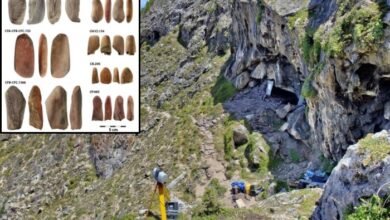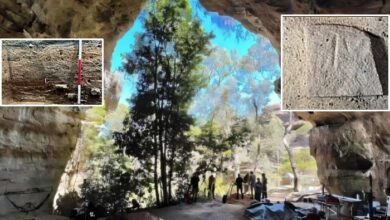Large Mammoth Tusk And Bones Buried For Thousands Of Years Found In North Dakota

Jan Bartek – AncientPages.com – Coal miners in North Dakota have discovered a 7-foot-long (2.1 meters) mammoth tusk that had been buried for thousands of years. A shovel operator at the Freedom Mine near Beulah was working the overnight shift when he suddenly spotted a flash of something white as he scooped up a giant mound of dirt and dropped it into a dump truck. He did not think about it and continued his work.
Coal miners unearthed a mammoth tusk at the Freedom Mine near Beulah, N.D while dumping into a truck. Credit: Coleman Fredricks
When he drove to the dumping site and unloaded his cargo, he decided to take a closer look at whatever it was he had seen before.
As reported by the Associated Press, it was then the crew realized they had actually found a mammoth tusk!
“We were very fortunate, lucky to find what we found,” said David Straley, an executive of North American Coal, which owns the mine.
The 45,000-acre (18,210-hectare) surface mine produces up to 16 million tons (14.5 million metric tons) of lignite coal annually. But that night, the miners had unearthed a priceless piece of history.
Jeff Person, a paleontologist with the North Dakota Geologic Survey, was among those to respond. He expressed surprise that the mammoth tusk hadn’t suffered more damage, considering the massive equipment used at the site.
“It’s miraculous that it came out pretty much unscathed,” Person told the Associated Press.
When experts investigated the site a second time and started digging, more surprising finds were made. This time, more than 20 bones, including a shoulder blade, ribs, a tooth, and parts of hips, were unearthed. According to scientists, this is most likely the most complete mammoth ever found in North Dakota.
“It’s not a lot of bones compared to how many are in the skeleton, but it’s enough that we know that this is all associated, and it’s a lot more than we’ve ever found of one animal together, so that’s really given us some significance,” Person said.
Mammoths once roamed across parts of Africa, Asia, Europe and North America. Specimens have been found throughout the United States and Canada, said Paul Ullmann, a University of North Dakota vertebrate paleontologist.
The mine’s discovery is fairly rare in North Dakota and the region, as many remains of animals alive during the last Ice Age were destroyed by glaciations and movements of ice sheets, Ullmann said.
Other areas have yielded more mammonth remains, such as bonebeds of skeletons in Texas and South Dakota. People even have found frozen carcasses in the permafrost of Canada and Siberia, he said.
Mammoths went extinct about 10,000 years ago in what is now North Dakota, according to the Geologic Survey. They were larger than elephants today and were covered in thick wool. Cave paintings dating back 13,000 years depict mammoths.
North Dakota Geologic Survey Paleontologist Jeff Person sits behind a 7-foot mammoth tusk. Credit: AP Photo/Jack Dura
Ullmann calls mammoths “media superstars almost as much as dinosaurs,” citing the “Ice Age” film franchise.
This ivory tusk, weighing more than 50 pounds (22.6 kilograms), is considered fragile. It has been wrapped in plastic as the paleontologists try to control how fast it dehydrates. Too quickly, and the bone could break apart and be destroyed, Person said.
See also: More Archaeology News
Other bones also have been wrapped in plastic and placed in drawers. The bones will remain in plastic for at least several months until the scientists can figure how to get the water out safely. The paleontologists will identify the mammoth species later, Person said.
The mining company plans to donate the bones to the state for educational purposes, the Associated Press reported.
Written by Jan Bartek – AncientPages.com Staff Writer






